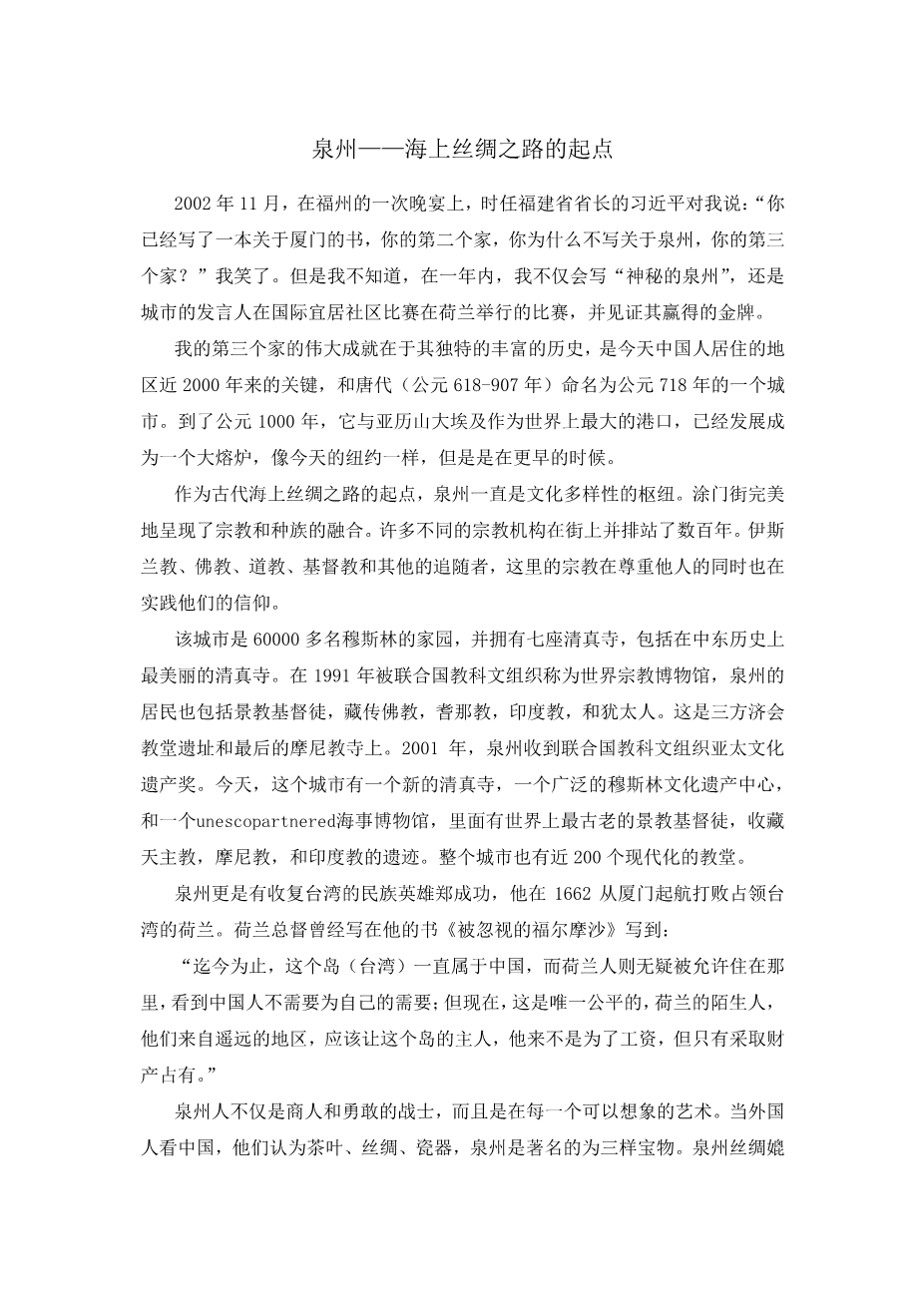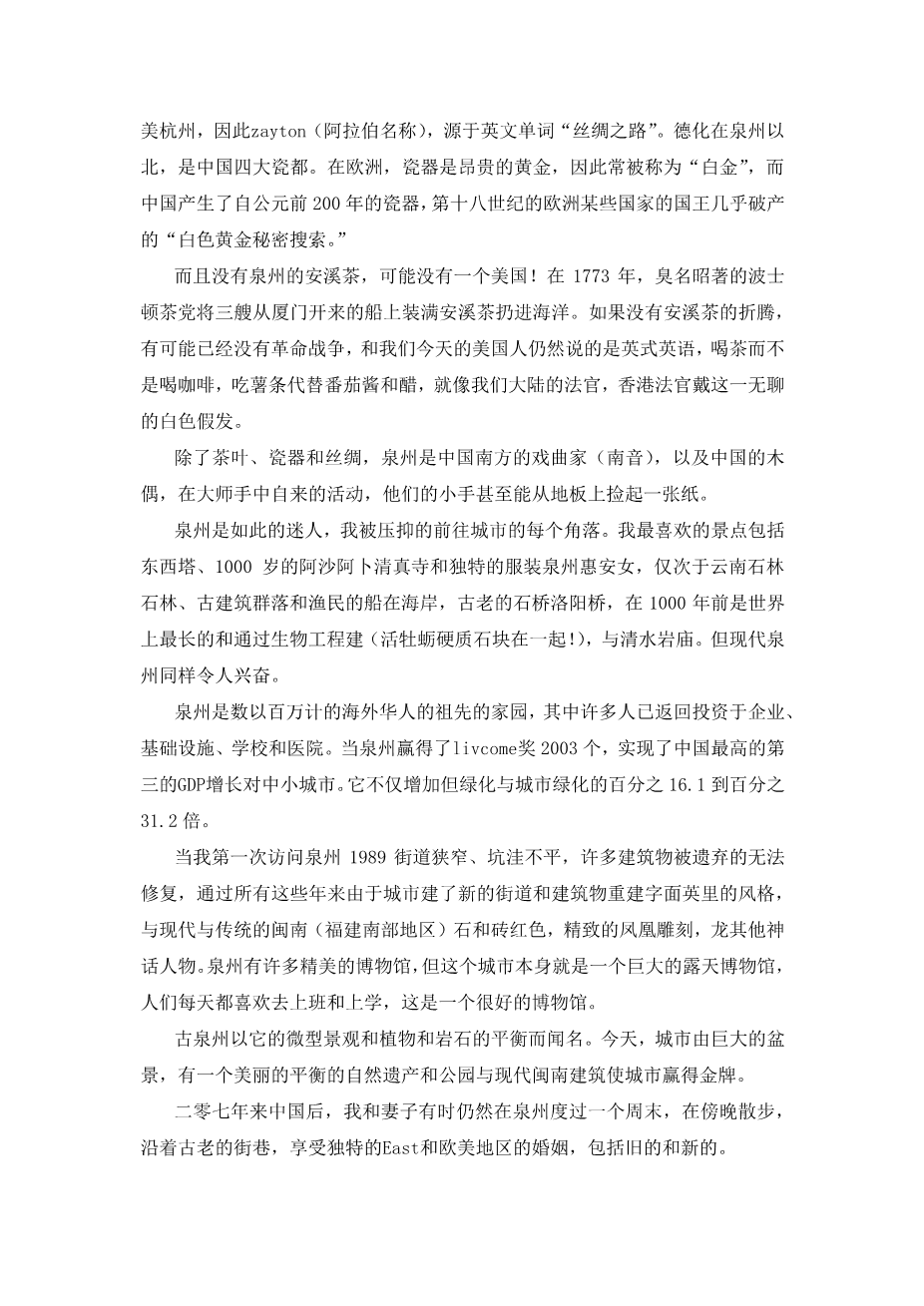Quanzhou— Start of the Maritime Silk Road
In November 2002, during a dinner in Fuzhou, then governor of Fujian Province Xi Jinping said to me: “You’ve written a book about Xiamen, your second home.Why don’t you write about Quanzhou,your third home?” I laughed. But I had no idea that within a year, I’d not only write “Mystic Quanzhou” but also be the city’s spokesman at the international Award for Livable Communities Competition held in the Netherlands, and witness its winning of the gold medal.
The key to my third home’s great successes today lie in its uniquely rich history – Chinese have lived in the area almost 2,000 years, and the Tang Dynasty (618-907) designated it as a city in AD 718. By AD 1000, it rivaled Alexandria in Egypt as the greatest port in the world and had developed into a melting pot like today’s New York, but a millennium earlier.
As the starting point of the ancient Maritime Silk Road, Quanzhou has always
been a hub of cultural diversity. Tumen Street perfectly illustrates this blend of religions and ethnicities. Many different religious institutions have stood side by side on the street for hundreds of years. Followers of Islam, Buddhism, Taoism, Christianity, and other
religions here practice their faiths while respecting others.
The city is home to 60,000 Muslims and has seated seven mosques, including
the most beautiful mosque outside of the Middle East, in its history. Designated in 1991 as a UNESCO World Museum of Religions, Quanzhou’s residents have also included Nestorian Christians, Tibetan Buddhists, Jains, Hindus, and Jews. It is site of three Franciscan cathedrals and of the last Manichaean Temple on earth. In 2001, Quanzhou received UNESCO’s Asia Pacific Cultural Heritage Award of Merit. Today, the city has a
new mosque, an extensive Muslim cultural heritage center, and a UNESCOpartnered
maritime museum that houses one of the world’s best collections of ancient Nestorian Christian, Catholic, Manichean, and Hindu relics. There are also almost 200 modern churches throughout the city.
Quanzhou was moreover home to heroes like Koxinga (Zheng Chenggong), hero of the Ming Dynasty (1368-1644), who in 1662 set sail from Xiamen to kick the Dutch out of Taiwan. The Dutch governor once wrote in his book Neglected Formosa :
“Hitherto this island (Taiwan) had always belonged to China, and the Dutch had doubtless been permitted to live there, seeing that the Chinese did not require it for themselves; but requiring it now, it was only fair that Dutch strangers, who came from far regions, should give way to the masters of the island … He came not with a view to wage … But only to take possession of his belongings.”
Quanzhou people are not only master merchants and brave warriors but also skilled in every art imaginable. When foreigners think of China, they think of tea, silk and porcelain, and Quanzhou was famed for all three. Quanzhou silk rivaled that of Hangzhou, hence the Arab name for it of Zayton, originating in the English word “silk.” Dehua, north of Quanzhou, was one of China’s four great porcelain centers. In Europe, porcelain was as costly as gold and consequently often called “white gold.” While Chinese had produced porcelain since 200 BC, certain 18th century European kings nearly bankrupted their countries in their search for the secret of “white gold.”
And had it not been for Quanzhou’s Anxi tea, there may not have been a United States! It was Anxi tea loaded on to three ships from Xiamen that rioters tossed into the ocean during the infamous Boston Tea Party of 1773. Had there been no Anxi tea to toss, there may have been no Revolutionary War, and today we Americans would still speak British English, drink tea instead of coffee, eat fries with vinegar instead of ketchup, and our judges would wear the silly white wigs that Hong Kong judges wear to this day.
In addition to tea, porcelain and silk, Quanzhou is the home of Southern Chinese Opera (Nanyin ), as well as Chinese marionettes, which in the hands of a master come to life, their tiny hands even capable of picking up a piece of paper from the floor.
Quanzhou is so fascinating that I’ve pent weeks traveling to every corner of the city. My favorite spots include the twin Kaiyuan Pagodas, the 1,000- year-old Ashab Mosque and uniquely costumed Hui’an maidens, the Stone Forest of Yongchun — second only to Yunnan’s Stone Forest, the ancient ship building communities and fishermen on the coast, ancient stone bridges, which 1,000 years ago were the longest in the world and built through biological engineering (live oysters cemented the stones together!), and Qingshuiyan Temple, which reminds me of a Fujianese version of the Potala Palace. But modern Quanzhou is just as exciting.
Quanzhou is the ancestral home of millions of overseas Chinese, many of whom have returned to invest in businesses, infrastructure, schools, and hospitals. When Quanzhou won the Livcome Awards in 2003, it had achieved China’s third highest GDP growth for medium-sized cities. It not only grew but greened, with urban greenery doubling from 16.1 percent to 31.2 percent.
When I first visited Quanzhou in 1989 its streets were narrow and potholed and many buildings derelict beyond repair Through all the years since the city has built new streets and rebuilt literally miles of buildings in a style that marries modern with traditional Minnan (South Fujian) — stone and red brick, with intricate carvings of the phoenix, dragon and other mythical figures. Quanzhou has many fine museums, but the city itself is one vast, open-air museum wherein people daily enjoy going to and from work and school.
Ancient Quanzhou was famous for its miniature landscapes and their balance of plants and rocks. Today, the city consists of giant miniature landscapes, with a beauti
剩余内容已隐藏,支付完成后下载完整资料


英语译文共 3 页,剩余内容已隐藏,支付完成后下载完整资料
资料编号:[484283],资料为PDF文档或Word文档,PDF文档可免费转换为Word
您可能感兴趣的文章
- COVID-19时期的旅游业和可持续发展:以西班牙为例外文翻译资料
- 农民相对剥夺感对乡村旅游可持续发展的影响机制外文翻译资料
- 校园大学生的旅行行为——以亚洲某乡村大学为例外文翻译资料
- 内容旅游与地方社区响应:鹫宫的“幸运之星”和“协作动漫旅游”外文翻译资料
- 基于符号互动理论的遗产旅游资源开发与重塑——以良渚古城遗址为例外文翻译资料
- 在TikTok上映射互联网名人:探索注意力、经济和可见性劳动力外文翻译资料
- 基于社区游客视角的环境责任行为的概念和度量外文翻译资料
- 温泉小镇的再造:维希的独特案例——副标题外文翻译资料
- 基于IP理念的桐乡丰子恺文化旅游开发研究外文翻译资料
- 特殊事件对旅游业的影响及其应对措施研究——新冠肺炎疫情对全球旅游业的影响及其应对措施外文翻译资料


